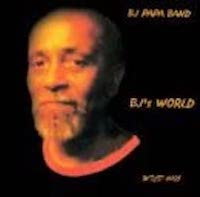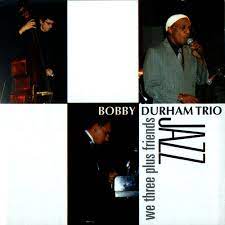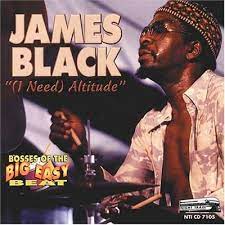
Daily Dose Of Jazz…
B.J. Papa was born on February 9, 1936 in Mobile, Alabama and as a child in the 1940s he was listening to all kinds of jazz and blues on the radio. Drafted into the Army in 1954 he became a medic and was stationed in San Francisco, California at Letterman Hospital in the Presidio. However, he ended up spending much of his service time playing on Army ball teams. By the time he turned 19 he found himself intrigued with the jazz bands booked into the Army noncommissioned officers clubs.
After his discharge from the service in 1956 Papa stayed in town and began saxophone lessons. He also made his first forays into the heart of the bustling Fillmore Street jazz community and would show up to listen and learn at the famous after-hours jams at Jimbo’s Bop City.
Over the course of his fifty year career Papa became a North Beach institution mentoring dozens of young cats making their transition from student to professional musician. He played with the biggest names in jazz to come through the city as well as passionate laymen sans pedigree.
Settling in at Jazz At Pearl’s, one of the few remaining jazz clubs that still possessed an air of authenticity before closing its doors, for thirteen years he shared the stage with an eclectic, enthusiastic audience nightly.
Pianist B.J. Papa, who always fed on and drew from the energy of the audience but has no recordings on line, transitioned on August 31, 2008.
More Posts: bandleader,history,instrumental,jazz,music,piano

Daily Dose Of Jazz…
Bobby Durham was born on February 3, 1937 in Philadelphia, Pennsylvania and learned to play drums while a child. He played with The Orioles at age 16, and was in a military band between 1956 and 1959. After his discharge, he played with King James and Stan Hunter.
1960 saw Durham moving to New York City, where he played with Lloyd Price, Wild Bill Davis, Lionel Hampton, Count Basie, Slide Hampton, Grant Green, Sweets Edison, Tommy Flanagan, Jimmy Rowles, and the Duke Ellington Orchestra, in which he played for five months. While working with Basie, he met Al Grey, and was a member of several of Grey’s small ensembles.
He accompanied Ella Fitzgerald for more than a decade, and worked with Oscar Peterson in a trio setting. Bobby played in trios with organists such as Charles Earland and Shirley Scott, and there was a resurgence in interest in his work during the acid jazz upswing in the 1990s. Many of his projects, both as sideman and as leader, came about because of his association with producer Norman Granz, who used him in performances with Fitzgerald, Basie, Edison, Flanagan, and Joe Pass.
He led his own combos, is noted for scat singing along with his drum solos. He recorded with Monty Alexander, Shawn Monteiro, Red Holloway, Milt Jackson, Clifford Jordan, and Jay McShann. He also performed often with pop and soul musicians such as Frank Sinatra, James Brown, Ray Charles, and Marvin Gaye.
Drummer Bobby Durham, who recorded five albums as a leader and twenty~three as a sideman, transitioned from lung cancer in Genoa, Italy at 71 on July 6, 2008.
More Posts: bandleader,drums,history,instrumental,jazz,music

Daily Dose Of Jazz…
James Norbert Black was born on February 1, 1940 in New Orleans, Louisiana. He played piano and trumpet during his youth and studied music at Southern University in Baton Rouge, Louisiana. He first started working in R&B ensembles as a drummer in the late 1950s, but took a job drumming with Ellis Marsalis in the New Orleans Playboy Club, leading to further work in jazz idioms.
A move to New York City in the mid-Sixties and worked in jazz idioms during the decade with Nat Perrilliat, Roy Montrell, Ellis Marsalis, Nat Adderley and Cannonball Adderley, Joe Jones, Horace Silver, Lionel Hampton, Yusef Lateef, Freddie Hubbard, and Eric Gale.
Returning to New Orleans near the end of the 1960s, playing there with Dr. John, James Booker, Fats Domino, Professor Longhair, Charles Neville, James Rivers, Earl Turbinton and the Dukes of Dixieland. Scram Records brought James on as a session musician, and can be heard on Eddie Bo’s single Hook and Sling. In the 1980s he worked with Cassandra Wilson, Wynton Marsalis, and Germaine Bazzle.
Black was a composer and received two grants from the National Endowment for the Arts. Among his works are Monkey Puzzle and Dee Wee, both of which were recorded by Ellis Marsalis’s ensemble in the early 1960s. Recordings under his name were compiled by Night Train Records and released on CD as I Need Altitude: Rare and Unreleased New Orleans Jazz and Funk, 1968-1978.
Drummer James Black, closely associated with the New Orleans jazz scene, transitioned on August 30, 1988.
More Posts: bandleader,drums,history,instrumental,jazz,music

Daily Dose Of Jazz…
Lenny McBrowne was born Leonard Louis McBrowne in Brooklyn, New York on January 24, 1933. Influenced by his drummer father Arnold he took up drums at a young age, playing in street marching bands between ages 12 and 15, while also taking lessons on the bass. Graduating high school in 1951 he studied under Max Roach for one year and Sticks Evans.
McBrowne began his professional career in Pete Brown’s group, which featured Paul Bley. He also played with Randy Weston and Cecil Payne in various Brooklyn clubs, and with Paul Bley’s Trio in Montreal, Quebec, Canada. By 1956 he was playing with Tony Scott in New York City, and continued performing with Paul Bley in a college tour that led to his relocation to California.
His first West Coast dates included the likes of Billie Holiday, Sonny Stitt, Harold Land, Benny Golson, Curtis Fuller, Fred Katz and Sonny Rollins. 1959 saw Lenny forming his own group, The Four Souls, with pianist Terry Trotter, bassist Herbie Lewis, tenor saxophonist and composer Daniel Jackson, and trumpeter Donald Sleet.
Between January and March 1960, The band recorded their debut album Lenny McBrowne and the 4 Souls in 1960 that was released by Pacific Jazz Records. Shortly after they relocated to New York City and recorded their second and final album Eastern Lights with Jimmy Bond on bass. Cannonball Adderley was the producer and supervisor and the album was released by Riverside Records.
Described as a highly close-knit and well-rehearsed combo with fluid and competent soloing by several leading jazz magazines, the group was destined for dissolution. Lenny then free-lanced with Sal Salvador, Chris Connor and Carmen McRae. During the 1960s, he played with Sarah Vaughan, Lambert, Hendricks & Bavan, Randy Weston, Booker Ervin, Ray Bryant, Teddy Wilson, and toured Japan with Thelonious Monk.
In the second half of the 1960s, McBrowne played primarily with Ervin’s band. He then relocated to San Francisco, California and began to perform with Kenny Burrell on a regular basis until 1976, when he made his last recording. Hard bop and soul jazz drummer Lenny McBrowne transitioned on October 4, 1980 at 47 in San Francisco, California.
More Posts: bandleader,drums,history,instrumental,jazz,music

Three Wishes
While hanging out with Larry Gales one evening Nica asked him what he would wish for if given three he said:
- “Eternal life.”
- “More knowledge of the instrument.”
- “Safe journey.”
More Posts: baroness,bass,history,instrumental,jazz,music,pannonica,three,wishes



